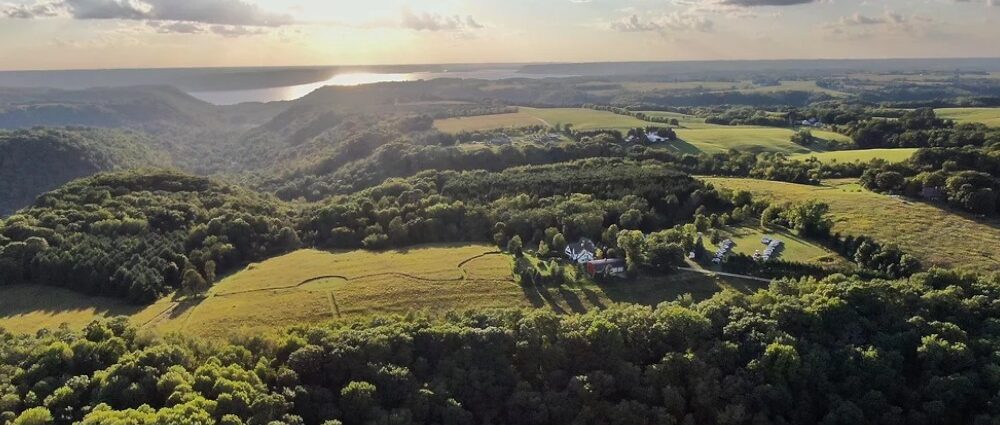ABOUT STOCKHOLM
Located on the shores of Lake Pepin, one of Nature’s great works of Art!
Experience the delightful Village of Stockholm located on the Wisconsin Great River Road.
* * An All American Road * *
 History
History
In 1851 Swedish adventurer Erik Petterson climbed the bluff behind Stockholm, saw Lake Pepin spreading out before him, and declared it the ideal site for a settlement. In the next year he made his first land purchase and two years later, he and his brother Jacob each brought over a party of immigrants. The land along a reces
In 1851 Swedish adventurer Erik Petterson climbed the bluff behind Stockholm, saw Lake Pepin spreading out before him, and declared it the ideal site for a settlement. In the next year he made his first land purchase and two years later, he and his brother Jacob each brought over a party of immigrants. The land along a recess in the shoreline was surveyed, and in 1856 Stockholm was officially born.
s in the shoreline was surveyed, and in 1856 Stockholm was officially born.
In short order, the village became a stopover for Scandinavian immigrants to western Wisconsin as well as a thriving farming center. At its population peak of 280 in 1880, it boasted three general stores, two hardware stores, and two blacksmith shops. In 1886 the railroad connected the village to farms and commercial centers up and down the river.
As the rural population began to dwindle after World War I, the village stayed alive with grain warehousing and brokerage, clamming activity, a commercial fishing operation, ice harvesting for a wide radius of cities, and dealerships in newly mechanized farm machinery.
After World War II, the flight to the cities and loss of the railroad station nearly took Stockholm off the map. But the beauty and tranquility of the land was not lost on a new generation of visitors. Starting in the 1970’s, artists and urban outsiders began to trickle into the village and surrounding countryside, reviving old storefronts and homes and creating a vibrant cultural life. A new breed of entrepreneurs arrived on their heels, each attuned to the possibilities of a unique merchant community, responsive to the melding of Swedish heritage, natural beauty, and the hum of artistic activity.
Places to see around STOCKHOLM
Stockholm Park
Village activity once extended to the lake, with a grain warehouse, brickyard, lumber yard, tannery, fish company, jail, and several residences. Periodic flooding led to the departure of the last of these buildings in the 1940s. After years with little use, the land was donated to the village to establish a public park stretching from the railroad tracks to the lake. The upper expanse of open grass, historically known as “the meadow,” has become the village green, doubling as a parking lot on major festive occasions. Closer to the lake are picnic tables, campsites, a boat launch, and restrooms. A 750-foot pier originally built in 1885 to harbor steamboats has become a favorite place to stroll or fish. The park is also an important venue for art fairs and other events, drawing people from far-flung cities and towns in the Upper Midwest.
Maiden Rock Bluffs
This famous limestone formation first caught public attention as the site of a legendary lover’s leap over two hundred years ago. The story has many versions, but the one constant is that Winona (“young maid” in Dakota) leaped to her death after being denied her wish to marry the man of her choosing.Located two miles north of Stockholm, the bluff is now protected and maintained as a State Natural Area by the Wisconsin DNR.
Lake Pepin
Regarded by early explorers as one of the great natural wonders of the Midwest, Lake Pepin retains its near-pristine shoreline and uninterrupted 23-mile expanse of water. Wildlife once teemed along its shores, making it a favorite hunting ground and gathering place for Native Americans of numerous tribes. The Great River Road between Maiden Rock and Stockholm, created as a work relief project in 1935, has been rated the most beautiful drive on the Mississippi River and the most scenic drive in the United States.
Fort St. Antoine
A drive-out and a bronze tablet mark the site of the oldest known white settlement on Lake Pepin. Built by the French in 1686, the fort stood below the current highway, around seventy feet above the high water mark. The farmers who resettled the area two centuries later repurposed the fort’s materials, leaving no definitive evidence of its precise location.

